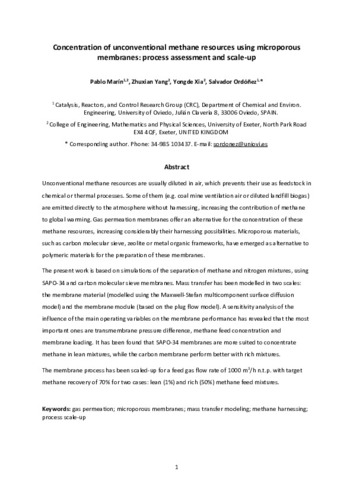Concentration of unconventional methane resources using microporous membranes: Process assessment and scale-up
Autor(es) y otros:
Fecha de publicación:
Versión del editor:
Citación:
Descripción física:
Resumen:
Unconventional methane resources are usually diluted in air, which prevents their use as feedstock in chemical or thermal processes. Some of them (e.g. coal mine ventilation air or diluted landfill biogas) are emitted directly to the atmosphere without harnessing, increasing the contribution of methane to global warming. Gas permeation membranes offer an alternative for the concentration of these methane resources, increasing considerably their harnessing possibilities. Microporous materials, such as carbon molecular sieve, zeolite or metal organic frameworks, have emerged as alternative to polymeric materials for the preparation of these membranes. The present work is based on simulations of the separation of methane and nitrogen mixtures, using SAPO-34 and carbon molecular sieve membranes. Mass transfer has been modelled in two scales: the membrane material (modelled using the Maxwell-Stefan multicomponent surface diffusion model) and the membrane module (based on the plug flow model). A sensitivity analysis of the influence of the main operating variables on the membrane performance has revealed that the most important ones are transmembrane pressure difference, methane feed concentration and membrane loading. It has been found that SAPO-34 membranes are more suited to concentrate methane in lean mixtures, while the carbon membrane perform better with rich mixtures. The membrane process has been scaled-up for a feed gas flow rate of 1000 m3 /h n.t.p. with target methane recovery of 70% for two cases: lean (1%) and rich (50%) methane feed mixtures.
Unconventional methane resources are usually diluted in air, which prevents their use as feedstock in chemical or thermal processes. Some of them (e.g. coal mine ventilation air or diluted landfill biogas) are emitted directly to the atmosphere without harnessing, increasing the contribution of methane to global warming. Gas permeation membranes offer an alternative for the concentration of these methane resources, increasing considerably their harnessing possibilities. Microporous materials, such as carbon molecular sieve, zeolite or metal organic frameworks, have emerged as alternative to polymeric materials for the preparation of these membranes. The present work is based on simulations of the separation of methane and nitrogen mixtures, using SAPO-34 and carbon molecular sieve membranes. Mass transfer has been modelled in two scales: the membrane material (modelled using the Maxwell-Stefan multicomponent surface diffusion model) and the membrane module (based on the plug flow model). A sensitivity analysis of the influence of the main operating variables on the membrane performance has revealed that the most important ones are transmembrane pressure difference, methane feed concentration and membrane loading. It has been found that SAPO-34 membranes are more suited to concentrate methane in lean mixtures, while the carbon membrane perform better with rich mixtures. The membrane process has been scaled-up for a feed gas flow rate of 1000 m3 /h n.t.p. with target methane recovery of 70% for two cases: lean (1%) and rich (50%) methane feed mixtures.
ISSN:
Patrocinado por:
This work has been financed by the Research Fund for Coal and Steel of the European Union (contract RFCS2016/754077-METHENERGYþ).
Colecciones
Ficheros en el ítem




